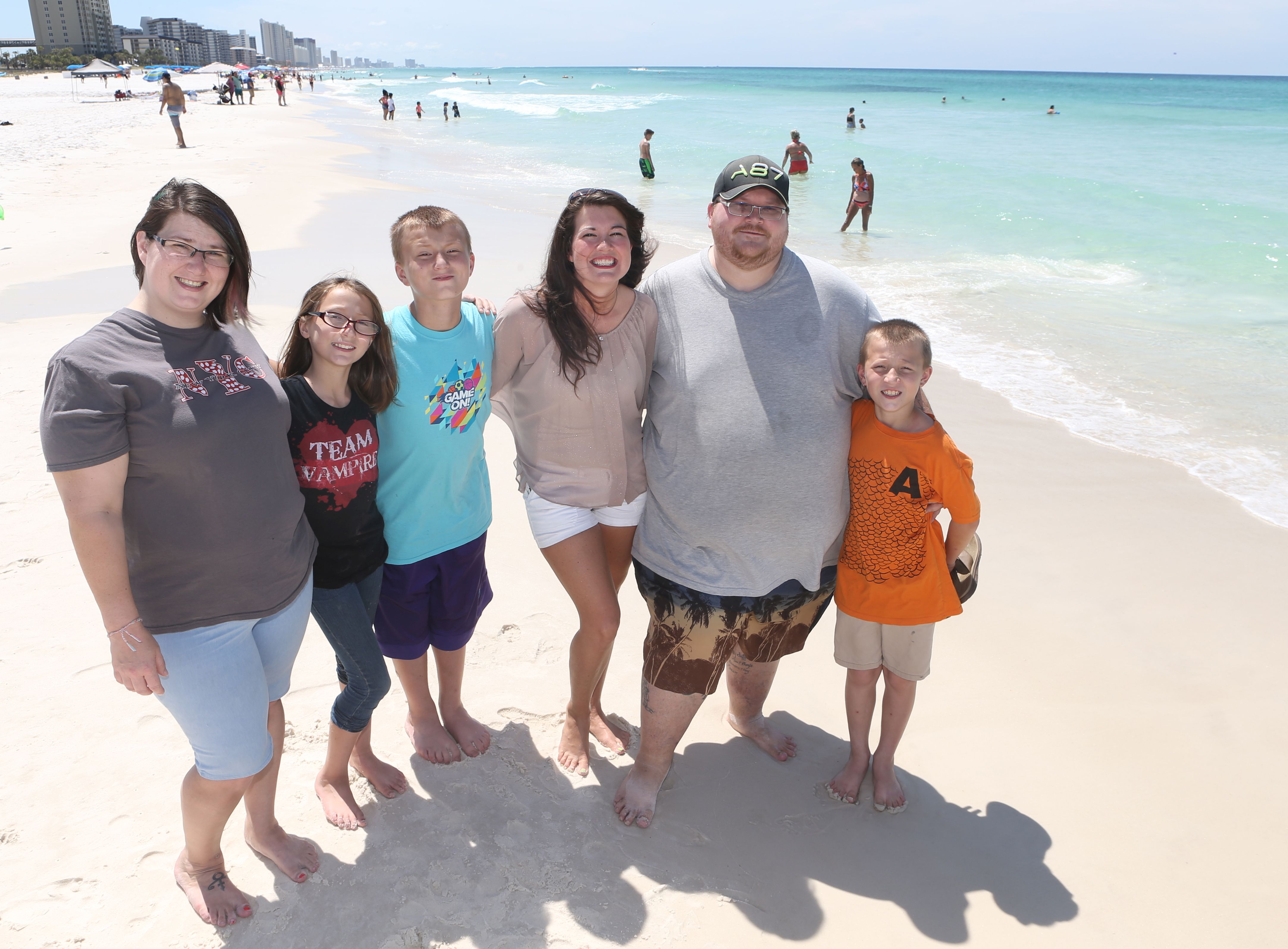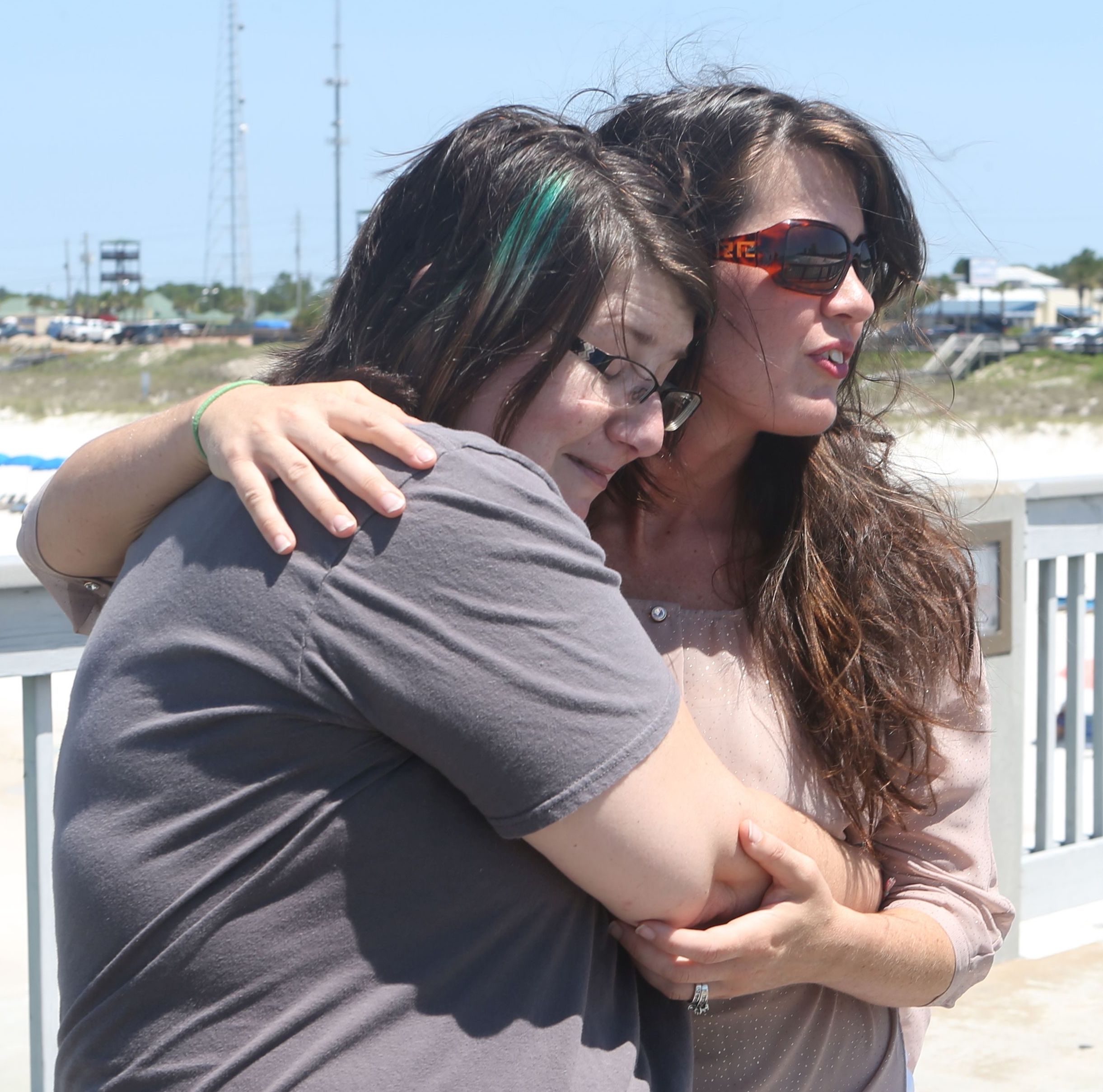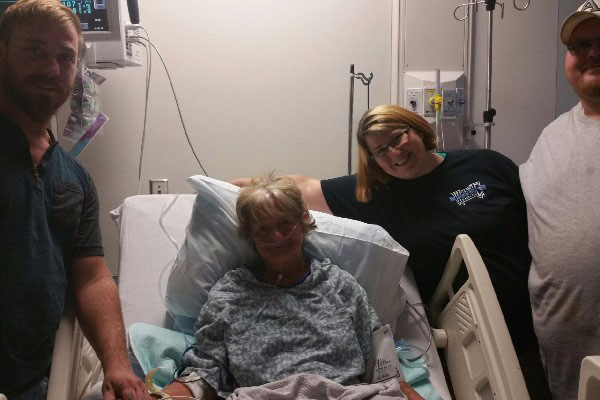Panama City Beach Rescue
Remembering the human chain rescue one year later
Beachgoers formed a human chain near the M.B. Miller County Pier on Saturday afternoon, July 8, 2017, off Panama City Beach, Florida, to rescue nine swimmers who were drowning. [Contributed photo]
Human chain rescuer and family reunite one year later
It’s a clear, warm day as Roberta Ursrey walks through the squeaky gate onto the M.B. Miller County Pier and gazes over the spot where, nearly a year ago, she’d swam out into the Gulf of Mexico and nearly died.
It’s the first time she’s been back to the pier since beachgoers formed an 80-person human chain to pull her, her entire family and several others back to shore after they were swept out in a rip current, a frighteningly common occurrence along the Gulf, particularly near the two piers that bookend this stretch of beach.
“All right here, a year ago,” Ursrey remarked. “We were right there and everybody was risking their lives to save us.”
While rip currents and rescues are frequent occurrences, the effort undertaken July 8, 2017, is not — not in Panama City Beach or anywhere in the world. The story took off, spanning the globe in an astoundingly short amount of time. The 24 hour news cycle delivered images of the amazing rescue, snapped from that very pier, to viewers in Europe and South America less than a day after Ursrey’s family was back on dry land. Ursrey and others involved, including Tabatha Monroe, who was also caught in the current, and Jessica Simmons, who along with her husband helped organize the chain and ferry the swimmers into waiting hands, recounted their tale hundreds of times to outlets all over the world, for Good Morning America, Inside Edition, CBS and others.

But even with all those stories, all the rehashing and reliving, the moment on the pier still caught Ursrey off guard. Her children bounded from one side of the pier to the other, looking down off the edge to excitedly point out fish swimming among the concrete legs of the pier. But Ursrey stands stark still, hand over her mouth as if suddenly, a year’s worth of emotions are catching up to her at once.
Just as she was a year ago, Simmons is right where Ursrey needs her, coming up behind the woman she helped save to put an arm around her shoulders as they watch the emerald waves break on white sand, both intimately aware of how quickly such a beautiful sight can turn deadly.
A lot has changed in a year.
Ursrey has a new job — she left the prison where she worked at the time of the rescue and now works the front desk at a resort, where every day she has a clear view of the Gulf. Her children — Noah, Bethany and Stephen, ages 12, 10 and 9 respectively — will start middle school, 5th grade and 3rd grade in the fall. Ursrey’s mother, Barbara Franz, who suffered a major heart attack during the ordeal, moved back to Georgia. Simmons’s husband got a new position in the military, and she’s spent much of the last year traveling across the country and world with him while also keeping up work on her degree from the University of Alabama remotely.
Yes, a lot has changed in a year but one large piece has stayed the same — the mark left on the by the dramatic human chain rescue, that moment of near-death foiled by unprecedented heroism.
Since the rescue, Simmons often finds herself on watch when she’s at the beach or near the water, keeping an eye on anyone who ventures too far out without a floatation device, saying it “makes her heart pound.” On red flag days, and some yellow days too, she opts instead for the pool at Frank Brown Park and younger children, nieces and nephews, don’t get in the Gulf without a life jacket. She still carries the boogie board she used to save Ursrey — it’s always in the back of her car or on their boat when she and her husband Derek Simmons go out to Shell Island where, as always, she takes up watch.
“I was like, ‘Man, I need to hold onto this boogie board because it saved nine people,’ ” Simmons said. “I’m ready to go at any moment. I even keep it with me on my boat when I go out. It’s bad.”

Ursrey now carries boogie boards too, “literally” eight of them packed into the back of her car, though their trips to the water are less frequent. Working at the resort and looking at the Gulf every day keeps the day fresh in her mind, and the recent spate of drownings this year have been “like a huge flashback” for her. She warns guests at the resort to be careful swimming in the Gulf, especially on red flag days, but many, she said, give her the brush off.
“People look at me like, ‘It’s okay,’” she said. “And I’m like, no it’s really not. I’ve been there and I don’t want anyone else to live that.”
Her children, who were caught in the current when she went to rescue them and got caught herself, are, at times, both remarkably flippant and surprisingly insightful about the ordeal. They all freely admit it’s something they think about every day, delivered in a very matter-of-fact tone. The first thing they do when they go to the beach is look for rip currents — they’ve become both excellent rip-current spotters and warning flag experts, Ursrey said — and while they say they’re not nervous to get in the water, there are times when they’ll huddle near shore.
Ursrey’s mother, who ended up coding in the ambulance after being pulled out of the Gulf and was brought back to life, is still recovering and has a long way to go. She’s still regularly seeing a cardiologist, and the stress of the ordeal aggravated an old back injury, which needed surgery. The trauma, Ursrey said, is something her mother will always carry with her.
“She’s getting by slowly,” Ursrey said. “She’s okay, but she still has a long way to go still.”

The days after the rescue, as the story spread like ripples in a pond, bringing hundreds of thousands of eyes to focus on Panama City Beach and, in turn, on those involved. Both women remember becoming exasperated with the attention. Ursrey remembers reporters calling her while she was at work at the prison pretending to be someone else just to reach her. Simmons has a similar story about reporters camped out in front of her house, her father-in-law telling them to go away.
“It got to the point where we were just silencing our phones,” Ursrey said.
It wasn’t that they were ungrateful, Ursrey said, in fact, it was the opposite. They’d shared their story to show gratitude for everyone who stepped in to help in the rescue, people who have largely remained anonymous, as Simmons said they mostly just dispersed after the rescue was over, no one thinking of getting names.
“We just wanted to say thank you,” Ursrey said.
Though overwhelming at times, the attention was always positive, Simmons said, adding that she still gets Facebook messages from people thanking her and showing support. A woman in Brazil and a country singer wrote songs about them, she said, and about a month later, they were all invited onto Good Morning America in New York City.
“It was amazing,” Simmons said. “I’m a city lights girl. That was right up my alley.”
They were also approached by a movie producer about the possibility of turning their story into a film, a turn of events that necessitated something Simmons never thought she would need — an entertainment lawyer.
“Do you know how hard it is to find an entertainment lawyer?” Simmons asked, jokingly. “There are none here.”
Out of everything, out of all the fear and the pain and the hurt and the frustration and the stories and the support, perhaps the most important development to come from the human chain rescue is the bond between Ursrey, Simmons and their families, the kind of bond formed in a life-or-death situation, that pulls deeper than friendship and possibly deeper than family itself. They keep in touch regularly, both on Facebook, where Ursrey’s husband will tease Simmons if she’s up too late doing homework, and in person, where the two women can talk “for hours.” Ursrey’s children hug Simmons as readily as they’d hug another member of their family, and the trio helped Simmons alleviate some of her extra Halloween candy last year.
“I think we would probably have never met had we never had this incident but now that we’ve met it’s like we’ve known each other forever,” Simmons said. “It’s really weird.”
Despite the sheer improbability of her and her husband being on the beach at exactly the right time one year ago, of some previous beachgoer leaving behind a boogie board and Simmons picking it up not knowing she would be using it minutes later to help save nine lives, of 80 people linking arms and plunging into danger to save a group of strangers, what happened that day isn’t strange to Simmons. There is a reason she was right where she needed to be, and there is a reason she and her husband saved those lives. It’s spiritual, and it’s certain and Simmons is excited to see what else life has in store.
“There was something that called us there,” she said. “I still think, to this day, there’s a reason Roberta and them are still alive. They’ve got big things coming to them.”
Psychologist explains nature of the human chain
Behind Derek Simmons, nine people were drowning in the Gulf of Mexico.
But he was focused on the people in front of him. The people who had gathered along the shoreline of Panama City Beach to watch. The people who could do something if they just moved.
Simmons has always been great at speeches. There are videos of him as a child, climbing on stage to preach in front of everyone. He can move crowds to tears but this day, he needed to move them to action.
“Don’t just stand there!” he remembers shouting. “There’s got to be some hope left for humanity in some of you.”
That’s when the extraordinary happened: Eighty strangers linked arms and formed a human chain, wading into waters so dangerous law enforcement officers on the beach were warning against it, and saved nine strangers.
It created a national moment that both defied conventional wisdom, but can also be explained by psychology, according to Florida State University psychology professor Dr. Tyler Towne.
“The reason that this story was so sensational was that it is, unfortunately, the exception to the rule,” Towne said. “That is not to say that the average person is not empathetic, or that they would not help someone in need if they felt that they had the ability, but there are a lot of impeding factors that bias us away from action during emergency situations.”
Self preservation, for example, often keeps people from plunging in, especially when they’re frequently told the first step in an emergency is making sure they themselves are safe (like the speech given on planes about securing your own mask before helping others). And it’s worth noting the human chain story is, in a way, an example of why this advice is given — originally there were just two victims, two boys, but that number swelled to nine, as seven people went in to save them and needed saving themselves.
Then there’s the confusion that accompanies these situations, Towne said. The questions of — what should I do? Do they actually need my help? There’s the panic.There’s the uncertainty. There’s the lack of organization. There’s the belief that someone more qualified should step in.
Plus, Towne said, research has shown that the more people present during an emergency, the less likely each person is to actually help someone in need.
In other words, there are a lot of logical reasons why an otherwise caring person would not put a toe in the water.
But, defying all that logic, an estimated 80 people — many of whom never received any recognition — headed directly into the rip current.
Which leads to the question — why was this moment different?
What it likely boils down to is, as studies show, is this: human behavior is contagious.
This is true for bad things — for example if a friend becomes obese, studies show you are more likely to become obese — and good things, like being willing to form a human chain.
“It is in human nature to conform to the behavior of those around us,” Towne said. “If enough people are looking up at the sky, we can’t help but look as well. Once a group behavior reaches a critical point, the likelihood of others joining in increases dramatically.
“Of course, this requires a clear plan and the perception that such a plan will work,” he added.
While Simmons was rallying the onlookers, two other people were making big decisions next to him.
One was Simmons’ wife Jessica, who found a boogie board cleaning up the beach and was getting ready to make her own attempt to save the nine victims. She considered herself to be an unusually strong swimmer and not the type of person who watches.
“The company I work for, I had a couple ladies tell me that. ‘I would have never done that, I would have never put myself out there,’” Jessica Simmons said. “We all have some type of hero in ourselves. We just have to find out where it’s at.”
And the other was Shaun Jernigan, who reportedly pulled together the first few links of the chain, with Derek Simmons calling for others to link on.
Jernigan and Jessica Simmons set the example. Derek Simmons gave people the plan and a personal invitation. Combined, it created a behaviour that was contagious.
Because while there are a lot of paralyzing factors in a crisis — particularly for large groups — studies also show people who believe they can help want to help, Towne said. When push comes to shove, people want to be the hero.
“There are clear social rewards for helping other,” said Towne. “This is baked into our biological and psychological dispositions, pro-social behavior is good for society and those who engage in it on a regular basis are rewarded with praise, friendships, social opportunities, and other desirable social outcomes.”
If the people on the beach didn’t have any hope for humanity left before Derek Simmons rallying cry, it would be hard to not have at least some faith restored after.
Because at the critical, pivotal and terrifying moment, 80 people found a way to overcome the weaknesses of being human — the fear, the panic, the at times selfishness — and instead found the best of humanity — bravery, kindness, selflessness and the ability to link arms with others to do something bigger than one person can do alone.
It’s the type of moments fairy tales and superhero stories are built on, but it’s also real. And what the human chain showed is with an example and rallying cry, the ability to be a superhero is there in all of us.
We just need faith.
To see the original story, visit here.